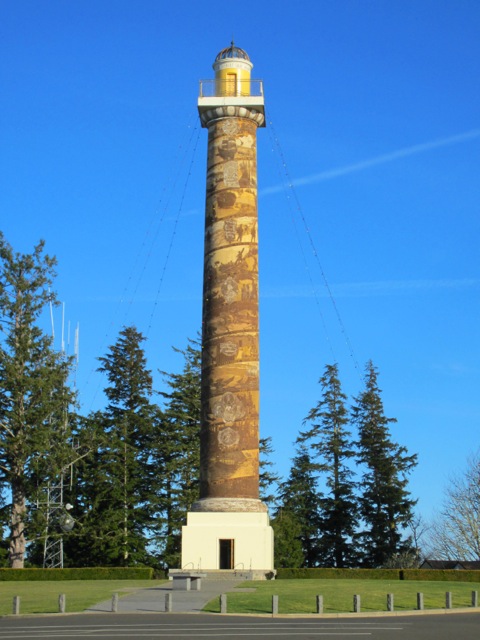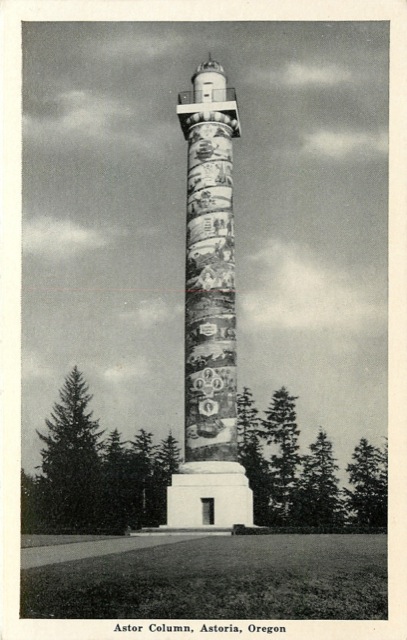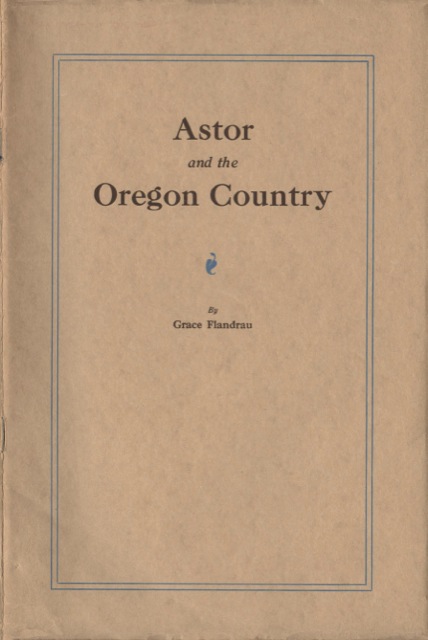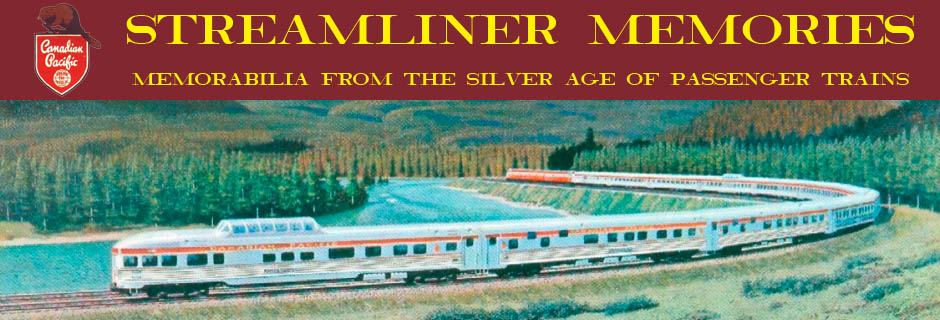July 22 was in some ways the climax of the Columbia River Historical Expedition, as the group spent the day dedicating the grandest monument built as a part of the Great Northern’s historical tours–and also the only one not immediately adjacent to a GN or SP&S right of way. Standing 125 feet tall, the Astoria Column has a 164-stair spiral staircase inside leading to a viewing platform near the top. The outside of the column is decorated with a spiral history of the Columbia, featuring Robert Gray, Lewis & Clark, the Astoria fur traders, early pioneers, and the coming of the railroad.
 The Astor Column in 2011. Wikimedia commons photo by Another Believer.
The Astor Column in 2011. Wikimedia commons photo by Another Believer.
The column was designed by Electus Litchfield (who had also designed the Camp Disappointment obelisk) and modeled after Trajan’s Column in Rome. It was built by A. Guthrie, a St. Paul construction company that had long been an important contractor for the Great Northern. Guthrie was digging the 7.9-mile Cascade Tunnel at the same time as it was building the Astor Column, and in 1930 it would receive the contract to build the Great Northern’s California extension from Bend, Oregon. The column’s exterior frescoes were by Attilio Pusteria, an Italian artist who immigrated to the United States in about 1900. Only about a third of these frescoes were completed by the time the expedition arrived to dedicate the column; Pusteria finished them by the end of October, 1926.
 Is it the Astor Column or the Astoria Column? Most of the publicity when it was unveiled and today’s “Friends of the Astoria Column” use the longer name. This postcard, which was probably made soon after the column was built, uses just “Astor.” The back of the card notes that it was “built by the heirs of John Jacob Astor and Great Northern Railway.” Click image to download a PDF of this card.
Is it the Astor Column or the Astoria Column? Most of the publicity when it was unveiled and today’s “Friends of the Astoria Column” use the longer name. This postcard, which was probably made soon after the column was built, uses just “Astor.” The back of the card notes that it was “built by the heirs of John Jacob Astor and Great Northern Railway.” Click image to download a PDF of this card.
According to Friends of the Astoria Column, the column cost more than $27,000, or about $350,000 in today’s money. Press reports of the day indicate the cost was more than $100,000; the lower number may be the column alone while the higher number includes improvements around it and possibly even the art that adorns it. Either way, this was more than the Great Northern was willing to spend, but Budd was able to persuade family patriarch Vincent Astor, who just happened to be Great Northern’s largest individual stockholder at the time, to contribute most of the cost.
The city celebrated its new monument for three days, and more than 8,000 people attended the column’s dedication. A few of them came from Portland by train, but most came from Astoria, which must have looked like a ghost town that day as the city’s population at the time was about 10,000.
At the dedication, lectures were given by writer/editor Lawrence Abbott on the connections between Astoria and New York; British Columbia Judge Frederic Howay on the maritime explorers who followed Captain Robert Gray, the first European-American to see the Columbia River; and Margaret Aldrich, a great-great-granddaughter of John Jacob Astor, who told some family stories about the man responsible for the founding of Astoria.
 Click to download a PDF of this booklet by Grace Flandrau.
Click to download a PDF of this booklet by Grace Flandrau.
After touring local salmon canneries, the expedition returned east as far as Longview, Washington, where they helped dedicate a new bridge across the Cowlitz River, which had been built in just 62 days. In the spirit of the expedition, Longview named it the “Pioneer Bridge.” The group then had dinner in the cafeteria of a local woodworking mill and toured what was then the world’s largest sawmill. Then the train returned overnight to Spokane.
